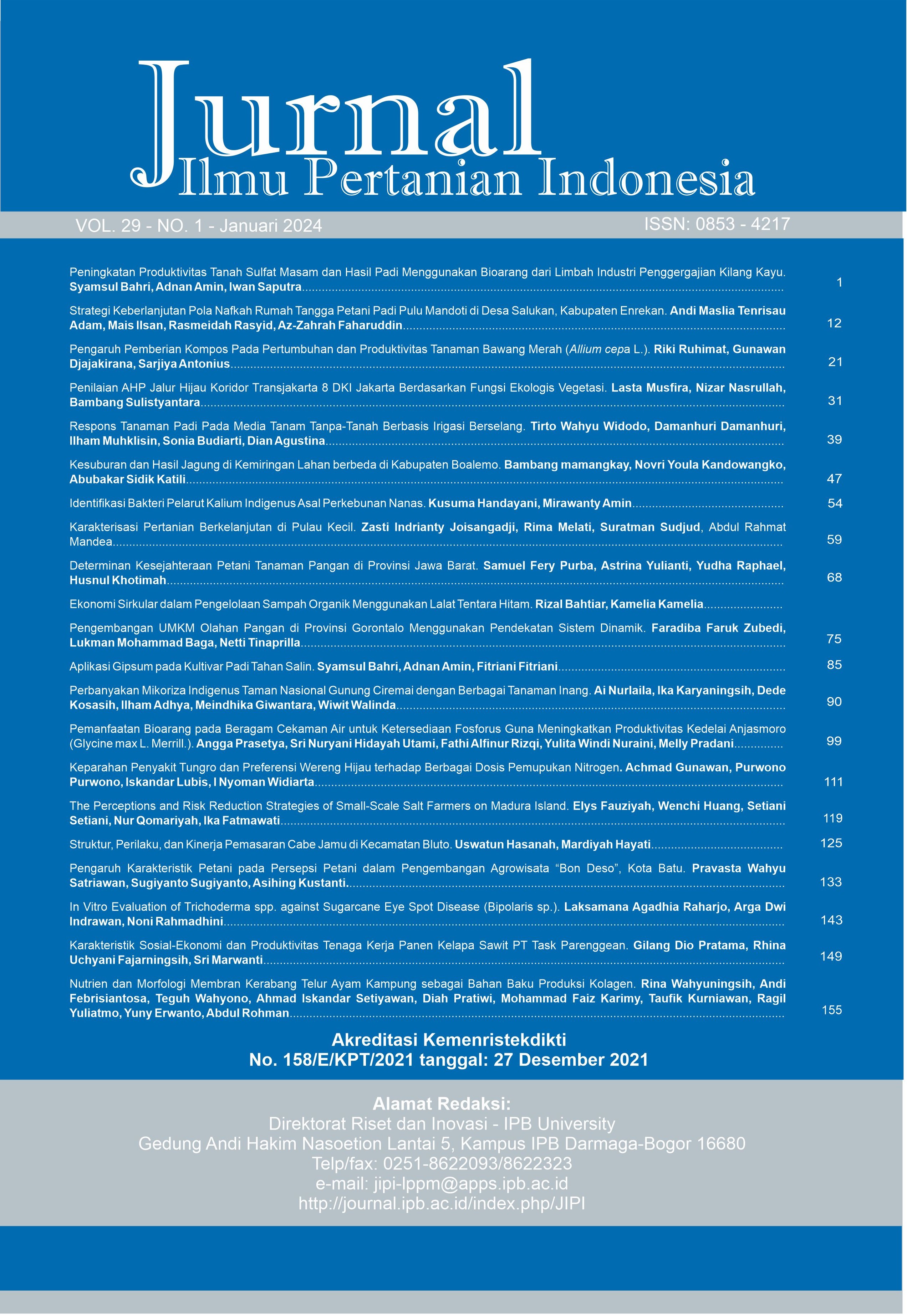Aplikasi Gipsum pada Kultivar Padi Tahan Salin
Abstract
Global climate change is predicted to increase the marginal land area, especially saline land, which affects the productivity of rice yields, so proper land management and tolerant varieties are needed. This study aimed to compare saline-tolerant cultivars and productivity at several concentrations of gypsum applications. The research was conducted on saline paddy soil in Cinta Raja Village, East Langsa District, Langsa City. We used fourteen cultivars studied, i.e., Batang Hari, Mendawak, Malaisia, Beres, Siak Raya, Martapura, Dendang, Air Tenggulan, Lambur, Banyuasin, Panasur, Impari, Indra Giri, and Margasari. The best results were found at the application of 1.5 tons per ha gypsum on the Dendang variety (G1V7) as shown by the higher plant height, i.e., 47.67, 60.53, and 71.20 cm at the ages of 30, 45, and 60 DAP, the number of tillers rice was 43.87 at 50 HST, and 39.87 at 60 DAP. The average weight of 1000-grains iwa 28.87 g, and an estimated yield was 7.63 tons ha-1. In conclusion, the Dendang variety, with the application of 1.5 tons of gypsum per ha, can be recommended for planting in saline soils.
Keywords: gypsum, rice variety, salinity, sodium
Downloads
References
Abidin AAZ, Yee WS, Rahman NSA, Idris ZHC, Yusof ZNB. 2016. Osmotic, oxidative and salinity stresses upregulate the expressions of Thiamine (Vitamin B1) biosynthesis genes (Thic and THI1/THI4) in oil palm (Elaisgueneensis). Journal of Oil Palm Research. 28 (3). https://doi.org/10.21894/jopr.2016.2803.07
Adji S.S. 2008. Pengaruh pencucian pada tanah tercemar natrium terhadap pertumbuhan tanaman. Jurnal Matematika Sains dan Teknologi. 9(1): 21–30.
Brinker M, Brosche M, Vinocur B, Aboogiala A, Fayyaz P, Janz D, Altman A. 2010. Linking the salt transcriptome with physiological responses of salt-resistant populus spesies as a strategy to Identify genes important for stress acclimation. Plant Physiology. 154(1): 1697–1709. https://doi.org/10.1104/pp.110.164152
[BPS] Badan Pusat Statistik. 2022. Penduduk Indonesia. Hasil Sensus Penduduk 2022. Jakarta (ID): Badan Pusat Statistik.
[FAO]. 2018. 20 Hal Untuk Diketahui Tentang Dampak Air Laut Pada Lahan Pertanian Profinsi NAD, Panduan Lapang FAO. [internet]. Diakses pada tanggal:. Tersedia pada: http://www.fao.org/ag/tsunami/docs/20_things_on_salinity_Bahasa.pdf [Accessed: 12 May 2018]
Hasanah LA. 2022. Analisis Faktor-Faktor Pengaruh Terjadinya Impor Beras di Indonesia Setelah Swasembada Pangan. GROWTH Jurnal Ilmiah Ekonomi Pembangunan. 1(2): 57–72.
Irawan AH, Maryani Y, Darnawi D, Arnanto. 2021. Ketahanan salinitas terhadap aspek agronomi padi varietas IR 64, Inpari 42, Inpari 33, Nutri zink, Ciherang. Jurnal Ilmiah Agroust. 5(1): 13–23.
Lubis MS. 2012. Uji stabilitas galur padi (Oryza sativa L.) pada tanah salin dan sulfat masam dengan menggunakan analisis Ammi dan sidik lintas produksi dan komponen produksi [Tesis]. Medan (ID): Universitas Sumatera Utara
Munns R, Tester M. 2008. Mechanisms of salinity tolerance. Annu. Rev. Plant. Biol. 59: 651–68. https://doi.org/10.1146/annurev.arplant.59.032607.092911
Negrao S, Schmockel SM, Tester M. 2017. Evaluating physiological responses of plant to salinity stress. Annals of Botany. 119: 1‒11. https://doi.org/10.1093/aob/mcw191
Purwaningrahayu RD. 2016. Karakter morfofisiologi dan agronomi kedelai toleran salinitas. Iptek Tanaman Pangan. 11(1): 3548.
Rahnama A, James RA, Poustini K, Munns R. 2010. Stomatal conductanceas a screen for osmotic stress tolerance in durum wheat growing in saline soil. Journal of Functional Plant Biology. 37: 255‒263. https://doi.org/10.1071/FP09148
Rengel Z. 2010. Mineral Nutriton of Crops, Fundamental Mechanisms and Implication. Binghamton: Food Production Press
Satoto, Widyastuti Y, Rumanti IA, Sudibyo TWU. 2010. Stabilitas hasil padi hibrida varietas hipa 7 dan Hipa 8 dan ketahanan terhadap hawar daun bakteri dan tungro. Penelitian Pertanian Tanaman Pangan, 29(3): 129–135.
Semendyaeva NV, Korobovab LN, Elizarovb NV. 2014. Changes in the properties and biological activity of crusty colonetzes in the Baraba Lowland Under the long term impact of gypsum. Eurasian Soil Science 47: 1116–1122. https://doi.org/10.1134/S1064229314110118
Suhartini T, Harjosudarmo TZP. 2017. Toleransi plasma nutfah padi lokal terhadap salinitas. Buletin Plasma Nutfah. 23(1): 51–58. https://doi.org/10.21082/blpn.v23n1.2017.p51-58
Torey, Patricia, Nio, Song, Siahaan, Parluhutan, Mambu, Susan. 2014. Karakter morfologi akar sebagai indikator kekurangan air pada padi lokal Superwin. Jurnal Bios Logos. (3): 154‒163. https://doi.org/10.35799/jbl.3.2.2013.4431
Utama MZH, Haryoko W, Munir R, Sunadi. 2019. Penapisan padi toleran salinitas pada lahan rawa di Kabupaten Pesisir Selatan. J. Argon Indonesia. 37(2): 101–106.
Saleh S. 2015. Genetic Variability agronomic performance of ten genotypes waxy corn (Zea mays L.). Jurnal Agrotan. 1(2): 81‒93.
Copyright (c) 2023 fitriani fitriani

This work is licensed under a Creative Commons Attribution-NonCommercial 4.0 International License.
This journal is published under the terms of the Creative Commons Attribution-NonCommercial 4.0 International License. Authors who publish with this journal agree to the following terms: Authors retain copyright and grant the journal right of first publication with the work simultaneously licensed under a Creative Commons Attribution-NonCommercial 4.0 International License. Attribution — You must give appropriate credit, provide a link to the license, and indicate if changes were made. You may do so in any reasonable manner, but not in any way that suggests the licensor endorses you or your use. NonCommercial — You may not use the material for commercial purposes.






















